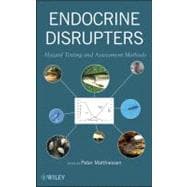
What is included with this book?
PETER MATTHIESSEN, PhD, is an aquatic ecotoxicologist who works as an independent consultant. Specializing in the study of endocrine disrupters, he has conducted extensive research into how sewage effluents cause feminization in wild male fish as well as how tributyltin-based antifoulants cause masculinization in wild female mollusks. Professor Matthiessen is a member of the UK Advisory Committee on Pesticides and Co-chair of the OECD Validation Management Group for Ecotoxicity Tests. He has contributed to the development of standardized ecotoxicity assays with sensitivity for endocrine disrupters as well as written guidance for the interpretation of the resulting data.
Preface
Chapter 1. Introduction
Peter Matthiessen
1.1 Background
1.2 Regulatory concerns
1.3 Invertebrates
1.4 Vertebrates
1.5 Testing schemes for EDCs
1.6 References
Chapter 2. Endocrine disruption in wildlife: background, effects and implications
Dick Vethaak and Juliette Legler
2.1 Background to endocrine disruption
2.2 Effects of EDCs on wildlife
2.3 The weight of evidence and ecological significance of ED effects
2.4 Implications for effect assessment and toxicity testing
2.5 Need for more field studies and an integrated approach
2.6 Concluding points
2.7 References
Chapter 3. The regulatory need for tests to detect EDCs and assess their hazards to wildlife
Hans-Christian Stolzenberg, Tobias Frische, Anne Gourmelon, Taisen Iguchi, Flemming Ingerslev, Mike Roberts, and Gary Timm
3.1 Emerging concerns and policy responses, focusing on EDCs as a large pseudo-uniform group of substances
3.2 General approaches in substance-related regulatory frameworks (EU)
3.3 How to make EDC definitions operational for substance-related regulatory work
3.4 Future perspectives
3.5 Conclusions
3.6 References
Chapter 4. Techniques for measuring endocrine disruption in insects
Lennart Weltje
4.1 Introduction
4.2 Methods
4.3 Discussion
4.4 Conclusions
4.5 Acknowledgements
4.6 References
Chapter 5. Crustaceans
Magnus Breitholtz
5.1 Introduction
5.2 Background to crustacean endocrinology
5.3 State of the art - what do we know about endocrine disruption in crustaceans?
5.4 Available subchronic/chronic standard test protocols
5.5 Complementary tools for identification of endocrine disruption
5.6 Summary and conclusions
5.7 References
6. Endocrine disruption in mollusks (processes and testing
Patricia D. McClellan-Green
6.1 Background and introduction
6.2 What constitutes the endocrine system in mollusks?
6.3 Endpoints and biomarkers of endocrine disruption
6.4 Current test methods using mollusks
6.5 Proposed test methods
6.6 Conclusions
6.7 References
7. Using fish to detect endocrine disrupters and assess their potential environmental hazards
Peter Matthiessen
7.1 Introduction
7.2 International efforts to standardise fish-based methods for screening and testing endocrine disrupting chemicals
7.3 Fish-based screens developed by OECD for endocrine disrupting chemicals
7.4 Progress with developing fish partial life-cycle tests for endocrine disrupters
7.5 Prospects for the standardisation of fish full life-cycle and multi-generation tests
7.6 Strengths and weaknesses of a hazard evaluation strategy based partly on available and proposed fish screens and tests
7.7 Conclusions
7.8 References
8. Screening and testing for endocrine disrupting chemicals in amphibian models
Daniel B. Pickford
8.1 Introduction
8.2 Potential uses of amphibians in endocrine disrupter screening and testing programmes
8.3 Embryonic development
8.4 Hatching
8.5 Larval development
8.6 Higher tier tests with amphibians
8.7 Other and emerging test methods
8.8 Summary and conclusions
8.9 References
9. Endocrine disruption and reptiles: using the unique attributes of temperature-dependent sex determination to assess impacts
Satomi Kohno and Louis J. Guillette Jr.
9.1 Introduction
9.2 Approaches to examine effects of EDCs
9.3 Induction of sex reversal in ovo
9.4 Analysis of sex-reversed animals
9.5 Conclusions
9.6 References
10. Birds
Paul D. Jones, Markus Hecker, Steve Wiseman and John P. Giesy
10.1 Introduction
10.2 Differences between birds and mammals and among bird species
10.3 In vitro techniques
10.4 Studies with embryos
10.5 In vivo techniques
10.6 Examples of EDC effects from field studies
10.7 Proposed 2-generation test
10.8 Conclusions
10.9 References
11. Mammalian methods for detecting and assessing endocrine-active compounds
M. Sue Marty
11.1 Introduction
11.2 Mammalian Tier 1 screening assays
11.3 Tier 2 tests
11.4 Human and wildlife relevance of estrogen, androgen and thyroid screening assays
11.5 Potential future assays for endocrine screening
11.6 References
12. Application of the OECD Conceptual Framework for assessing the human health and ecological effects of endocrine disrupters
Thomas H. Hutchinson, Jenny Odum and Anne Gourmelon
12.1 Introduction
12.2 Overview of the OECD revised Conceptual Framework
12.3 Application of the ‘Klimisch Criteria’ to the EE2 and VIN case studies
12.4 Case study: data examples for 17α-ethinylestradiol (EE2)
12.5 Case study: data examples for vinclozolin (VIN)
12.6 Conclusions
12.7 Disclaimer
12.8 References
13. The prospects for routine testing of chemicals for endocrine disrupting properties and potential ecological impacts
Peter Matthiessen
13.1 Introduction
13.2 Are there gaps in the testing suite for EDCs?
13.3 ‘New’ modes of endocrine disrupting action
13.4 How should tests for EDCs be deployed in an integrated fashion?
13.5 Use of weight-of-evidence when assessing possible EDCs
13.6 Conclusions
13.7 References
Index
The New copy of this book will include any supplemental materials advertised. Please check the title of the book to determine if it should include any access cards, study guides, lab manuals, CDs, etc.
The Used, Rental and eBook copies of this book are not guaranteed to include any supplemental materials. Typically, only the book itself is included. This is true even if the title states it includes any access cards, study guides, lab manuals, CDs, etc.